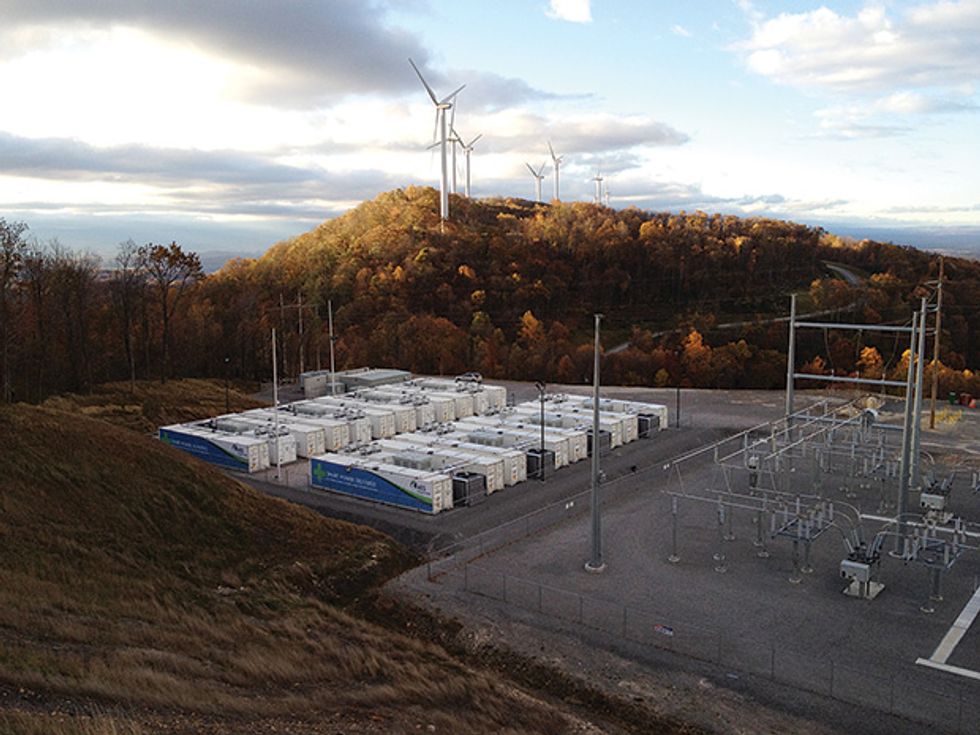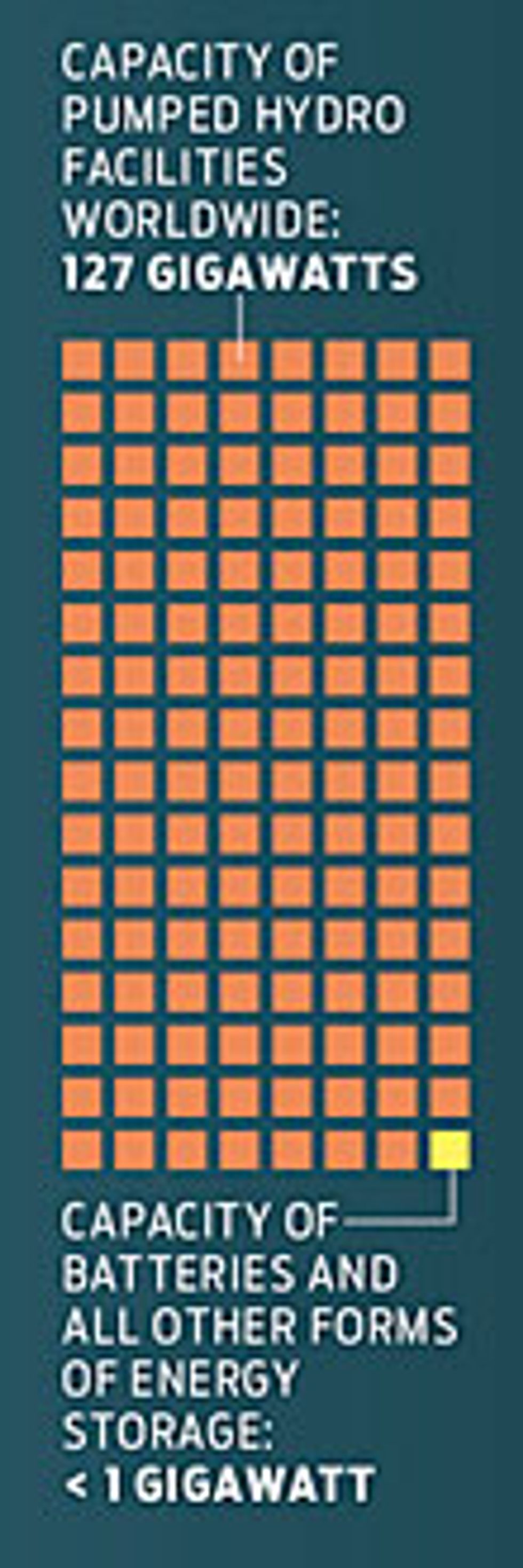A Battery as Big as the Grid
2012 could mark the arrival of utility-scale battery storage


Sometime this quarter, a shovel will sink into the dry desert soil of a Mexicali industrial park, breaking ground for the construction of an unprecedented energy-storage facility. Once completed, its batteries will be able to feed a full gigawatt into the grid for 4 to 6 hours.
By far the largest installation of its kind anywhere, it will help keep the lights on in Baja California and in the future, Southern California, just across the border. It should also improve the reliability of both the Mexican and U.S. grids and pave the way for using more solar and wind power. And with dozens of other battery--based energy-storage projects in the works elsewhere in the world, 2012 may be a turning point for the electricity industry—where up to now, adding new capacity has always meant building an expensive new power plant.
At press time, Jacob Rikard Nielsen, vice president of business development for Rubenius, the Dubai-based company behind the Mexicali project, said plans were still being finalized, including a timeline for the project and the type of batteries it would use. The work builds on two smaller energy-storage sites the company has installed in Abu Dhabi, which use sodium-sulfur batteries from the Japanese company NGK.
One of the chief drivers of the Mexicali project is California’s goal of having 33 percent of its electricity come from renewable sources by 2020. “They’re already seeing problems today in terms of grid stability and flexibility,” Nielsen says.
Eric Wesoff, an industry analyst with Greentech Media, explains why: “A wind farm only works when the blades are spinning. It might have a nameplate capacity of 100 megawatts, but it never puts out that much. Sometimes it’s 70; sometimes it’s nothing. To a grid operator, that kind of resource is a headache rather than an aspirin.” To compensate for solar and wind’s fitfulness, utilities end up building more gas turbines.
Using a bank of batteries allows utilities to even out the supply of renewable electricity. “So now that 100-MW wind farm can say, We’re a 40-MW, steady-state, 24/7 energy source—more like a coal plant,” Wesoff says. “That’s more valuable to society.”
Utilities have long avoided batteries, because the technology was too expensive and not robust enough to last for tens of thousands of charging cycles. At present, the world’s biggest grid-scale battery [PDF] is a bank of nickel cadmium cells in Fairbanks, Alaska, which can produce up to 52 MW of emergency backup power for about 15 minutes.
Some electric utilities store energy by pumping water uphill and then recapture the stored energy by allowing the water to flow back downhill through turbines. Worldwide, pumped hydro facilities can produce about 127 gigawatts this way. Compressed air is also used as a storage medium, a strategy that yields just a few hundred megawatts in total, about as much as battery-based energy-storage facilities can now produce.
But thanks to investments made by the consumer-electronics and electric-vehicle industries, battery technology has advanced enormously in just the past decade. “Today you’ve got two or three batteries on your person at all times,” notes Haresh Kamath, program manager for energy-storage research at the Electric Power Research Institute (EPRI). “The research applied to those industries is now being applied to batteries for the grid.”
The potential market for grid-scale storage is substantial. Rubenius estimates it at US $30 billion per year, “plus or minus $5 billion,” Nielsen says. “Of course, that’s not going to materialize tomorrow. But as the technology matures and utilities gain experience, we’ll get to that market status in the next 10 years. I’m quite optimistic.”
However, a lot of work remains between now and then, Kamath notes. Although many companies are touting novel battery technologies for grid-scale storage, only a few have been tested in a utility setting. Another stumbling block is terminology. Utility equipment tends to be rated in terms of straight watts—for example, a 40-MW transformer or a 60-MW feeder. Storage, though, is power supplied over some limited duration, so there’s the added element of time.
How you express that time turns out to be important. Let’s say you have a battery installation that can supply 10 MW for 4 hours. You may be tempted to describe that as having a capacity of 40 megawatt-hours, but it doesn’t mean the installation can provide 40 MW for 1 hour or even 20 MW for 2 hours. Right now, the utilities and the battery manufacturers tend to use different terminology when describing the same thing. “That’s been a major obstacle in the energy-storage industry,” says Kamath. “We [at EPRI] try to translate so there’s no confusion.”
That said, the activity in battery storage is “probably a couple orders of magnitude greater than just 10 years ago,” Kamath says. “Rather than isolated efforts, we’re seeing major players spending serious money.” Utilities, too, are much more enthusiastic about battery storage, he says, whereas in the past there was only “polite interest.”
That shift in attitude was apparent last year, when the Long Island Power Authority (LIPA), in New York, put out a bid for proposals to add 2500 MW of capacity to its network. Though 15 of the 16 companies that responded proposed the usual range of generating options, AES Energy Storage, based in Arlington, Va., proposed to fulfill a portion of LIPA’s needs with a 400-MW battery site.
In a densely populated area, the proposed installation would have several advantages over a traditional power plant, including “no emissions, no water usage, no fuel lines, and no noise,” says Chris Shelton, president of AES. LIPA is expected to announce the winning bids later this quarter or next.
In addition to the Long Island project, AES is pitching a similar 100-MW facility for El Paso, Texas, and several others that it has not yet disclosed to the public. By the end of last year, it had installed 76 MW of battery storage, including a recently opened 32-MW lithium-ion battery site adjacent to a wind farm near Elkins, W.Va., and two smaller deployments in Chile. The lithium-ion batteries that AES is using in Elkins can discharge their rated power for about 15 minutes, not nearly enough to make the wind farm a round-the-clock electricity source, but enough to smooth out some of the wind’s variability.
The company got into grid-scale energy storage in 2007. “Back then, a 1-MW system seemed like a really big battery,” says John Zahurancik, vice president of deployment and operations. “Then we moved up to 10 MW and now 32 MW. Looking out a few years, it’s not hard to see 400 MW. The question is not whether we will see these things but how quickly.”
Kamath is also optimistic for the long-term future of battery storage. “Once we have substantial amounts of storage on the grid, we’ll see fundamental changes in the way the grid works,” he says. Some proposals call for storage at the neighborhood or residential level. When you’re not using your electric car, for instance, it could be parked in your garage and supplement your household electricity needs during peak hours. “You could even have storage in each appliance,” Kamath says.
A refrigerator with a battery? “That day may come,” he says. “Because when it’s cycling on and off, it’s putting wear and tear on your electricity connection, and it makes the load on the grid more difficult to control. So maybe a battery there makes sense.”

